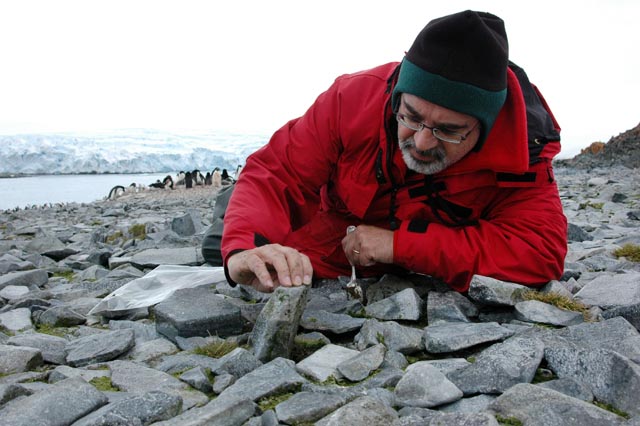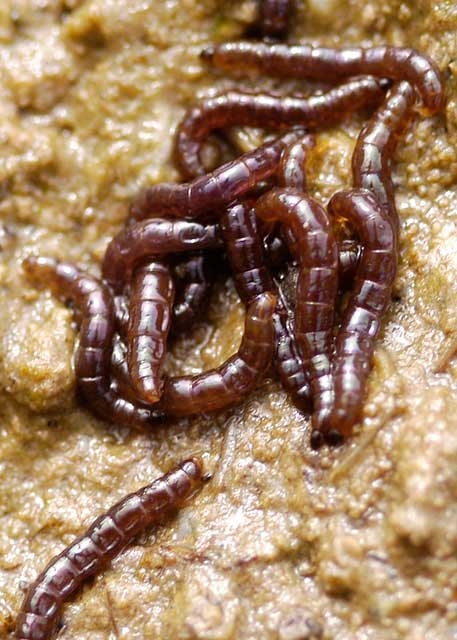Good things in small packagesAntarctic insect's tiny genome packs plenty of protection in polar climatePosted October 3, 2014
It makes sense that life in extreme environments requires an organism to be “lean and mean” to survive. The recently sequenced genome of Antarctica’s only endemic insect suggests that may apply genetically as well. In a paper published last month in the journal Nature Communications, researchers suggested that the compact genome of Belgica antarctica – missing much of the so-called “junk” DNA present in other species – may be an adaptation to living in the harshly cold and dry environment of Antarctica. 
Photo Credit: Peter Rejcek
Scientist David Denlinger says the genome of Antarctica's wingless midge may shed light on the adaptations of other tiny extremophiles.
Its genome contains only 99 million base pairs of nucleotides, making it smaller than any other insect sequenced thus far. In contrast, the human genome contains about three billion of these base pairs. “We really wanted the genome so we could get our hands on all the genes,” explained David Denlinger, a co-author on the paper and a professor in the Department of Entomology at The Ohio State University. “We weren’t seeking out the smallest genome. It turns out that’s just the way it is.” In fact, Denlinger and his colleagues were at first a bit suspicious of the results, and they employed a second technique called flow cytometry to verify the findings. Belgica is a member of the order Diptera, which includes mosquitoes and flies. They are found only on the Antarctic Peninsula and in a variety of diverse microhabitats, from small clumps of grasses found on the rocky islands to the well-fertilized mud near penguin rookeries and elephant seal wallows. The wingless midges have a two-year life cycle. They spend most of it as worm-like larvae, up to six millimeters long, eating all the bacteria, detritus and algae they can. They molt into adults in the austral summer, enjoying a brief flowering, two weeks at most, to mate and lay eggs. The eggs, looking like tiny dried tomato seeds, hatch after a week and the new larvae begin feeding. Denlinger and Richard Lee, director of the Laboratory of Ecophysiological Cryobiology at Miami University and another co-author on the Nature Communications paper, collected specimens from around the U.S. Antarctic Program’s coast research facility Palmer Station between 2009-10 and 2011-12. [See previous article — Not much bugs Belgica: Antarctic insect focus of new NSF-funded project.] NSF-funded research They recently received a new grant from the National Science Foundation’s Division of Polar Programs to continue their investigations into the molecular and physiological oddities that make Belgica antarctica the only true Antarctic bug. The three-year field project will begin in January 2016. “We’re pretty excited to connect the genomics with actually physiological function that we think makes a real difference for the organism,” Lee said. A genome is an organism’s complete set of DNA. Deoxyribonucleic acid, or DNA, is the chemical compound equivalent of both a construction and instruction manual for nearly all living things. DNA molecules are made of two twisting, paired strands, each of which is composed of four chemical units called nucleotide bases that comprise the genetic “alphabet.” The order of the bases determines the meaning of the information encoded in that part of the DNA molecule, just as the order of letters determines the meaning of a word. The Belgica genome provides the researchers “a toolbox” that they can use to understand various gene functions that previous genetics work only gave them hints about before. For example, aquaporin genes encode proteins that allow water into and out of a cell – an important function considering that Belgica loses up to 70 percent of its body water as part of a strategy to avoid freezing. Denlinger said previous efforts to clone the midge’s aquaporin genes resulted in accessing one type. The genome provides the scientists with five additional aquaporin genes. “This gives us a whole suite of genes that are in that family that we can use to carefully dissect their specific roles in losing water or uptaking water, for example,” Denlinger explained. “That’s a really important aspect of the physiology of this midge because losing water is important for its survival. It’s one of the things that allow it to survive a low temperature.” Denlinger, Lee and their team also plan to look more closely at the genetic connectivity between populations of Belgica across different islands off the Antarctic Peninsula for their next round of fieldwork. The theory is that the midge, lacking wings, is limited in its ability to disperse to different locations. Denlinger said a similar situation may exist on the islands around the peninsula that has been documented on the Galapagos Islands, where Charles Darwin witnessed speciation among the spatially separated finches. The genetics work did reveal that the midge was more widely distributed prior to the last major glaciation, about 20,000 years ago, when researchers believe Belgica was able to survive in isolated refuges. The isolation of the species has also meant little if any cross-fertilization of genetic material with other insects, particularly transposable elements, which is a DNA sequence that can change its position within the genome. Transposable elements are the main type of genetic material that scientists have identified in higher organisms that are transferred between different species and that may have significant impacts on their evolution. “The fact that this insect has had very little interaction with other insects means opportunities for horizontal transfer from one species to another probably haven’t happened very often,” Denlinger said. “That’s implicit in the genome that we have described. There are very few transposable elements, very few transposons in that genome.” The Belgica genome not only provides valuable insights into Antarctica’s largest terrestrial animal. (Penguins and the like don’t count, since they only spend part of their life cycle on land.) It may also hint at genetic makeup of other arthropods like mites and ticks, which are not insects but belong to a related class that includes spiders and scorpions. “I think it’s going to be fun to see if other extremophiles follow the same pattern of having smaller genomes,” Denlinger said. |



For USAP Participants |
For The Public |
For Researchers and EducatorsContact UsU.S. National Science FoundationOffice of Polar Programs Geosciences Directorate 2415 Eisenhower Avenue, Suite W7100 Alexandria, VA 22314 Sign up for the NSF Office of Polar Programs newsletter and events. Feedback Form |




